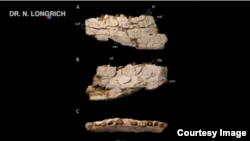Evidence of one of the last dinosaurs to live in Africa has been discovered in Morocco.
A fossilized dinosaur jawbone was recovered at a mine, which is about 100 kilometers west of the city of Marrakesh.
Researchers say the bone belonged to a creature they are calling Chenanisaurus Barbaricus.
Dinosaurs lived between about 230 and 65 million years ago. Then they died out. Scientists think an asteroid -- a huge rock from space – struck the Earth’s surface 66 million years ago.
They believe this event led to the disappearance of dinosaurs on our planet. This marked the end of the time period known as the Cretaceous Period.
Nick Longrich identified the new dinosaur species. Longrich is a paleontologist at the University of Bath. He says what is important about the discovery is that it shows how Africa had its own dinosaurs.
"We have a pretty good picture of the dinosaurs from North America for this time period. For example, Triceratops and T. Rex are part of this fauna, this sort of twilight fauna of the last dinosaurs on Earth. But we don't have a good picture of what's going on in the rest of the world and we know almost nothing about the African dinosaurs from this time period."
Nick Longrich thinks the Chenanisaurus was similar in appearance to the larger Tyrannosaurus Rex, also called T. Rex. But there were differences.
The Chenanisaurus had a shorter snout than the T. Rex. The area around its nose and mouth were not as big.
Longrich suspects that the T. Rex probably had feathers like a bird, but the Chenanisaurus did not. He also thinks the Chenanisaurus was less intelligent than the T. Rex because it had a smaller brain.
Longrich said researchers know the fossil comes from a dinosaur bone because of the teeth. Dinosaur teeth are usually serrated, pressured from side to side.
In addition, the edges of the teeth were rounded, as if they bit into bone. This suggests that the Chenanisaurus, like the T. Rex, hunted for its food.
For Longrich, the fossil discovery in Morocco is evidence for the theory of mass extinction of the dinosaurs.
"It's interesting to see evidence confirming that dinosaurs remained successful and the fauna stayed pretty stable up until the end of the Cretaceous period in Africa. So I think there is no evidence as far as I'm concerned of a decline in dinosaur diversity approaching the extinction, and if it hadn't been for this asteroid, we'd probably still have dinosaurs here today."
I’m Phil Dierking.
Faith Lapidus reported on this story for VOA News. Phil Dierking adapted her report for Learning English. George Grow was the editor.
Do you think there were dinosaurs in your part of the world? We want to hear from you. Write to us in the Comments Section or on our Facebook page.
_________________________________________________________________
Words in This Story
dinosaur - n. one of many reptiles that lived on Earth millions of years ago
extinction - n. the state or situation that results when something such as a plant or animal species has died out completely
fauna - n. all the animals that live in a particular area, time period, or environment
fossil - n. something such as a leaf, skeleton, or footprint that is from a plant or animal which lived in ancient times and that you can see in some rocks
snout - n. the long nose of some animals
paleontologist - n. a scientist that deals with the fossils of animals and plants that lived very long ago especially in the time of dinosaurs
serrated - adj. having a row of small points or teeth along the side like a saw









